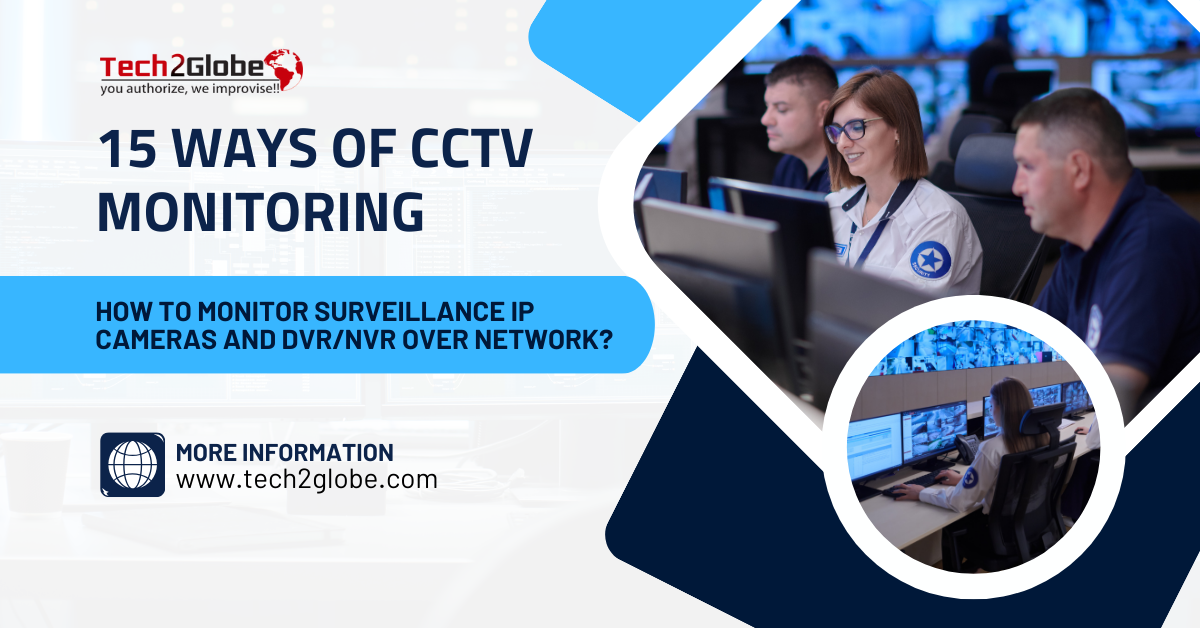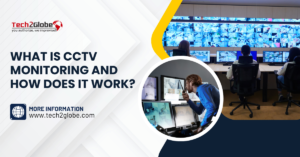CCTV monitoring has become an integral part of the modern security system, providing enhanced surveillance capabilities in homes, businesses, and public areas. Due to advances in technology, monitor for security cameras, IP surveillance cameras, and DVR/NVR systems have become more efficient and convenient than ever on networks.
The Digital Video Recorder (DVR) and Network Video Recorders (NVR) are two groundbreaking breakthroughs in the history of CCTV surveillance devices that aided the security industry’s advancement. These two items advanced the security camera monitor to the next level of video surveillance technology. A technological invention that turned analog camera impulses into visible digital format. With this readable digital format, the CCTV surveillance video footage might be saved on a hard disk. DVR, as we know it, developed as a game-changing device for the CCTV surveillance industry.
15 Ways of CCTV Monitoring – How to Monitor Surveillance IP Cameras and DVR/NVR over Network?
In this blog article, we’ll look at 15 ways of CCTV monitoring, providing you with the resources you need to get the most out of your surveillance system. And with Tech2Globe on your side, you can be confident that we have the experience to assist you at every step.
1. Ping Check
Consider the most basic and popular video surveillance system, which comprises IP cameras and a DVR connected to a single network. A simple ICMP ping of the recorder or cameras will tell you if they are operational. First, execute the application, add the camera to the host list, and set up the ping check. Then, you specify what to do if the ping fails. In our example, we will display a message on the security camera screen, but we can also set up the software to send notifications by SMS, email, Slack, execute a custom script, log into a file, or utilize other techniques.
2. SNMP check
Pinging cameras and DVRs is not always sufficient to determine their functionality. For example, a gadget may react to pings but not capture video. This problem may be solved with SNMP parameter monitoring. This check provides additional information about the device’s current status. Many devices implement the SNMP protocol. For instance, we may monitor a certain characteristic that indicates the DVR is no longer recording video. To start monitoring this parameter, create an SNMP check.
3. SNMP traps
In the case of a traditional SNMP check, the software makes queries to the device. When using SNMP traps, the device delivers messages to the software that include comparable information. We need to receive and decode it. Integrating this process into your surveillance system enhances CCTV monitoring security. First, enable transmitting SNMP traps in the device’s settings. Then, the application allows receiving and setting up notifications and alarms.
4. Checking the web interface (HTTP / HTTPS)
Typically, most DVRs or IP cameras allow access to their web interface using the HTTP protocol. Check if the web interface is available to see if the recorder or camera is functioning properly. In the HTTP, check if the server returns a response code 200; the camera then responds and does not hang. Otherwise, an alarm will be generated.
5. Email monitoring (POP3)
Some devices can communicate information about malfunctions or reports on regular operations via email. The application may produce alerts for both the existence of a special message and the lack of fresh messages during a specific period. When it stops receiving fresh emails, the application tells the administrator of the failure.
6. Mobile Access
Many current CCTV monitoring security systems have mobile apps that allow you to see camera feeds directly from your phone. Once the cameras are set up and connected to a network, you can browse live video feeds, review recorded material, and even receive alerts or notifications—all from your smartphone.
7. Log File analysis
Some video surveillance systems based on Windows computers include log files in which they record fault messages. You may watch the log file and look for disk write error messages. Set up file content checks and alarms for certain strings in the file. To provide the name of a new log file created daily by the system, use the current date substitution keys.
8. File count monitoring in the folder
Some DVRs may be integrated with storage systems such as QNAP. These servers run Linux or FreeBSD and back up records from hard disks. Checking the presence of files in a folder allows you to determine the number of files in a folder that have changed and contact the administrator; otherwise, nothing has changed since the prior time. Also, monitoring the security camera screen gives you a real-time view of changes or events.
9. Monitoring the number of files on the FTP server
A similar monitored CCTV security system may be set up utilizing an FTP server, which is where DVR recordings are saved. The FTP check application connects to a server and checks the number of files in a specified directory.
10. Remote Access
CCTV remote monitoring allows you to watch, manage, and control video cameras from a distance. In some circumstances, this means seeing a live stream while on the road, while in others, the system is designed to be handled remotely. Modern camera systems now provide features previously unavailable in traditional video surveillance.
11. Analysis of bandwidth on a network interface
The existence of traffic on IP cameras and DVR network interfaces is another indicator of their operational status. If a camera supports the SNMP protocol, you may view its traffic and bandwidth directly. If not, you can use SNMP to examine bandwidth on a controlled switch’s ports. If the camera’s baud rate goes below the given limit, the application will send an alarm.
12. Cloud-Based Monitoring
At its core, cloud video surveillance works on the principle of storing a remote server for capturing camera images. Unlike traditional local storage solutions, such as DVRs and NVRs, which are not only complicated but also expensive to maintain, the cloud offers a flexible alternative. By switching to cloud storage, businesses can reduce costs associated with hardware maintenance and upgrades, and a full suite of features and improved functionality can pave the way. Additionally, advanced features and functionality can be achieved through remote CCTV monitoring.
13. VMS Integration
A video management system (VMS) integrates software and hardware to monitor security cameras, alerts, and sensors automatically. VMS hardware may comprise cameras, encoders for analog camera systems, and servers for video processing and storage. VMS software monitors all systems and gives an overview that alerts security to potential or planned tasks.
14. PTZ(Pan-Tilt-Zoom) Camera Control
PTZ cameras may now be controlled using software like OBS, vMix, Wirecast, TriCaster, MimoLive, and Livestream Studio. Each software solution handles pan, tilt, zoom, and camera preset controls slightly differently, but the overall result is similar.
15. Video stream bitrate monitoring via RTSP
To determine if a camera is operating properly, check for a stable video feed at a specific bitrate using the RTSP protocol. The stream bitrate is dependent on weather and time circumstances. The usual bitrate is determined uniquely for each device. Create an RTSP monitoring check and set the threshold bitrate. The software will alert you if the current bitrate falls below the set limit.
Conclusion
Effective security camera monitor is essential for safeguarding your assets and ensuring peace of mind. Using smart strategies and tech can make your monitoring system more efficient and faster. With the help of Tech2Globe’s CCTV monitoring services , you can get the most out of your CCTV system.
As a leading CCTV monitoring company, we are committed to providing comprehensive solutions. Contact us today to elevate your surveillance strategy and we protect what matters most.










